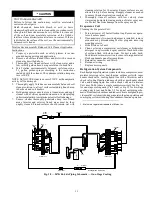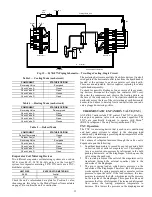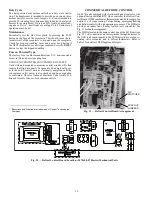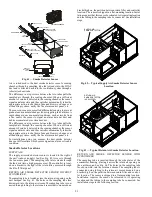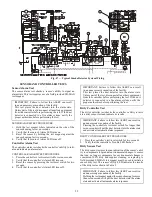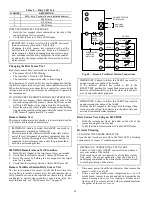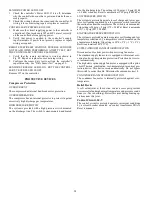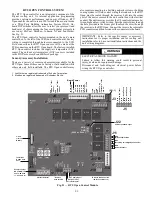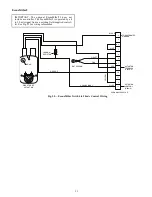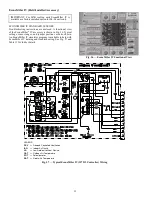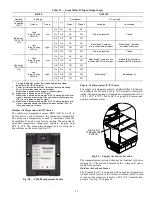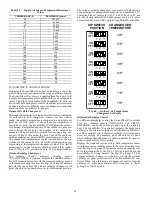
23
Fig. 41 — Smoke Detector Sensor
Air is introduced to the duct smoke detector sensor’s sensing
chamber through a sampling tube that extends into the HVAC
duct and is directed back into the ventilation system through a
(shorter) exhaust tube.
The difference in air pressure between the two tubes pulls the
sampled air through the sensing chamber. When a sufficient
amount of smoke is detected in the sensing chamber, the sensor
signals an alarm state and the controller automatically takes the
appropriate action to shut down fans and blowers, change over
air handling systems, notify the fire alarm control panel, etc.
The sensor uses a process called differential sensing to prevent
gradual environmental changes from triggering false alarms. A
rapid change in environmental conditions, such as smoke from
a fire, causes the sensor to signal an alarm state but dust and
debris accumulated over time does not.
The difference in air pressure between the two tubes pulls the
sampled air through the sensing chamber. When a sufficient
amount of smoke is detected in the sensing chamber, the sensor
signals an alarm state and the controller automatically takes the
appropriate action to shut down fans and blowers, change over
air handling systems, notify the fire alarm control panel, etc.
For installations using two sensors, the duct smoke detector
does not differentiate which sensor signals an alarm or trouble
condition.
Smoke Detector Locations
SUPPLY AIR
The supply air smoke detector sensor is located to the right of
the unit’s indoor (supply) fan. See Fig. 42. Access is through
the fan access panel. The sampling tube inlet extends through
the fan deck (into a high pressure area). The controller is locat
-
ed on a bracket to the right of the return filter, accessed through
the lift-off filter panel.
RETURN AIR SMOKE DETECTOR SENSOR WITHOUT
ECONOMIZER
The sampling tube is located across the return air opening on the
unit basepan. See Fig. 43. The holes in the sampling tube face
downward, into the return air stream. The sampling tube is con
-
nected through tubing to the return air sensor that is mounted on a
bracket high on the partition between return filter and controller
location. The sensor is shipped in a flat-mounting location. Instal
-
lation requires that this sensor be relocated to its operating location
and the tubing to the sampling tube be connected. See installation
steps.
Fig. 42 — Typical Supply Air Smoke Detector Sensor
Location
Fig. 43 — Typical Return Air Smoke Detector Location
RETURN AIR SMOKE DETECTOR SENSOR WITH
ECONOMIZER
The sampling tube is inserted through the side plates of the
economizer housing, placing it across the return air opening on
the unit basepan. See Fig. 44. The holes in the sampling tube
face downward, into the return air stream. The sampling tube is
connected using tubing to the return air sensor mounted on a
bracket high on the partition between return filter and control
-
ler location. The sensor is shipped in a flat-mounting location.
Installation requires the sensor be relocated to its operating
location and the tubing to the sampling tube be connected. See
installation steps in the following section.
SEE DETAIL
A
DETAIL
A
PLUG
SAMPLING TUBE
(ORDERED SEPARATELY)
COUPLING
MAGNETIC
TEST/RESET
SWITCH
ALARM
TROUBLE
POWER
DIRTY
SENSOR
COVER
COVER GASKET
(ORDERING OPTION)
SENSOR HOUSING
AND ELECTRONICS
EXHAUST GASKET
EXHAUST TUBE
DUCT SMOKE SENSOR
INTAKE
GASKET
TSD-CO2
(ORDERING OPTION)
SUPPLY AIR
SMOKE DETECTOR
RETURN AIR
SMOKE DETECTOR
(AS SHIPPED)
Содержание 547K
Страница 94: ...94 APPENDIX D WIRING DIAGRAMS Fig I 547K 04 06 Power Wiring Diagram 208 230 1 60 ...
Страница 95: ...95 APPENDIX D WIRING DIAGRAMS Fig J 547K 04 07 Power Wiring Diagram 208 230 3 60 ...
Страница 96: ...96 APPENDIX D WIRING DIAGRAMS Fig K 5047K 04 07 Power Wiring Diagram 460 575 3 60 ...



